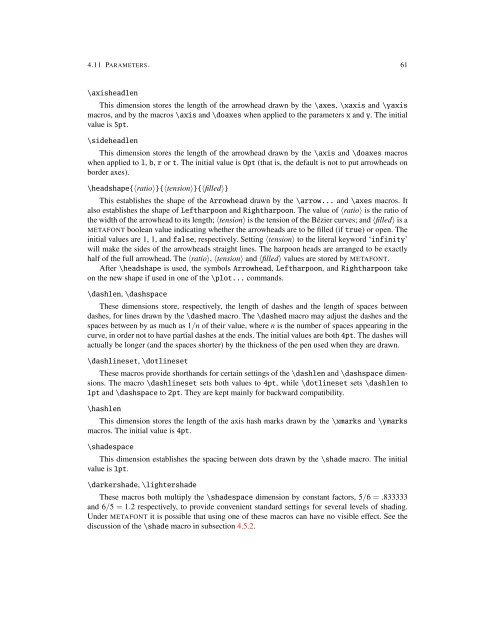You also want an ePaper? Increase the reach of your titles
YUMPU automatically turns print PDFs into web optimized ePapers that Google loves.
4.11 PARAMETERS. 61<br />
\axisheadlen<br />
This dimension stores the length of the arrowhead drawn by the \axes, \xaxis and \yaxis<br />
macros, and by the macros \axis and \doaxes when applied to the parameters x and y. The initial<br />
value is 5pt.<br />
\sideheadlen<br />
This dimension stores the length of the arrowhead drawn by the \axis and \doaxes macros<br />
when applied to l, b, r or t. The initial value is 0pt (that is, the default is not to put arrowheads on<br />
border axes).<br />
\headshape{〈ratio〉}{〈tension〉}{〈filled〉}<br />
This establishes the shape of the Arrowhead drawn by the \arrow... and \axes macros. It<br />
also establishes the shape of Leftharpoon and Rightharpoon. The value of 〈ratio〉 is the ratio of<br />
the width of the arrowhead to its length; 〈tension〉 is the tension of the Bézier curves; and 〈filled〉 is a<br />
METAFONT boolean value indicating whether the arrowheads are to be filled (if true) or open. The<br />
initial values are 1, 1, and false, respectively. Setting 〈tension〉 to the literal keyword ‘infinity’<br />
will make the sides of the arrowheads straight lines. The harpoon heads are arranged to be exactly<br />
half of the full arrowhead. The 〈ratio〉, 〈tension〉 and 〈filled〉 values are stored by METAFONT.<br />
After \headshape is used, the symbols Arrowhead, Leftharpoon, and Rightharpoon take<br />
on the new shape if used in one of the \plot... commands.<br />
\dashlen, \dashspace<br />
These dimensions store, respectively, the length of dashes and the length of spaces between<br />
dashes, for lines drawn by the \dashed macro. The \dashed macro may adjust the dashes and the<br />
spaces between by as much as 1/n of their value, where n is the number of spaces appearing in the<br />
curve, in order not to have partial dashes at the ends. The initial values are both 4pt. The dashes will<br />
actually be longer (and the spaces shorter) by the thickness of the pen used when they are drawn.<br />
\dashlineset, \dotlineset<br />
These macros provide shorthands for certain settings of the \dashlen and \dashspace dimensions.<br />
The macro \dashlineset sets both values to 4pt, while \dotlineset sets \dashlen to<br />
1pt and \dashspace to 2pt. They are kept mainly for backward compatibility.<br />
\hashlen<br />
This dimension stores the length of the axis hash marks drawn by the \xmarks and \ymarks<br />
macros. The initial value is 4pt.<br />
\shadespace<br />
This dimension establishes the spacing between dots drawn by the \shade macro. The initial<br />
value is 1pt.<br />
\darkershade, \lightershade<br />
These macros both multiply the \shadespace dimension by constant factors, 5/6 = .833333<br />
and 6/5 = 1.2 respectively, to provide convenient standard settings for several levels of shading.<br />
Under METAFONT it is possible that using one of these macros can have no visible effect. See the<br />
discussion of the \shade macro in subsection 4.5.2.

















